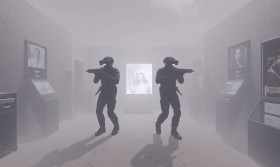Title: Forklift Operator Simulator VR: Warehouse Missions Expansion - The Next Leap in Immersive Logistics Training
The virtual reality landscape has long promised to revolutionize training and skill development across industries. In the realm of industrial and logistics training, Forklift Operator Simulator VR emerged as a pioneering force, offering a safe, cost-effective, and engaging platform to master the complexities of operating heavy machinery. Now, with its highly anticipated Warehouse Missions Expansion, the experience transcends mere simulation, evolving into a comprehensive and dynamic training ecosystem that prepares operators for the relentless pace of the modern warehouse.
Beyond Basic Controls: The Philosophy of the Expansion
The core simulator excelled at teaching the fundamentals: control familiarization, load handling, and basic maneuvering. The Warehouse Missions Expansion builds upon this foundation by introducing context, pressure, and consequence. It’s the crucial shift from knowing how to operate a forklift to understanding how to work as a forklift operator. This expansion is designed not just to test skill, but to cultivate situational awareness, time management, and problem-solving under constraints—the very skills that define a proficient operator in a real-world logistics environment.
A Deep Dive into the New Mission Archetypes
The expansion pack introduces a series of structured mission types, each targeting a specific set of competencies:
1. The Precision Retrieval Relay: This mission type emphasizes accuracy and spatial awareness. Operators are tasked with retrieving specific SKUs from high-density storage racks, often requiring double-deep maneuvering or navigating very narrow aisles. The challenge is compounded by a "damage multiplier" system; any collision with racking or incorrect load handling significantly impacts the final score. It teaches operators to respect their environment and the goods they handle, reinforcing that speed is meaningless without precision.
2. The Loading Bay Sprint: Here, the focus is on efficiency and speed under time pressure. A truck arrives at the virtual loading bay, and the operator must efficiently unload incoming pallets and then reload the truck with outbound orders, all against a ticking clock. This mission introduces the concept of "stacking integrity" and load balancing within a trailer, preventing players from simply piling pallets haphazardly. It’s a crash course in logistics flow, teaching operators to think several steps ahead.

3. The Inventory Audit Challenge: This mission swaps frantic pace for meticulous attention to detail. A section of the warehouse requires a cycle count. The operator must carefully navigate to specific locations, physically count items on pallets (often requiring them to lift or lower forks to eye level), and log any discrepancies. This mission trains operators to be an integral part of quality control, highlighting that their role is not just movement but also verification.
4. The Hazard Response Scenario: Safety is paramount, and this mission type tests it directly. Virtual emergencies like a spilled chemical drum, a pallet blocking a fire exit, or a minor racking collapse are introduced. The operator must follow correct safety protocols: parking the forklift safely, activating emergency signage, and using the correct procedure to contain or report the hazard. This provides invaluable, risk-free practice for high-stress situations that are rare in reality but critical to handle correctly.
Enhanced Realism and Environmental Dynamics
The expansion is more than a new set of tasks; it’s a richer world. The warehouse environment is now dynamic and reactive.
- Procedural Obstacles: AI-controlled pedestrian workers and other forklifts now navigate the warehouse floor, forcing the player to constantly be aware of their surroundings, use their horn appropriately, and right-of-way protocols.
- Variable Load Types: Beyond standard pallets, operators now handle unstable loads like sheet glass or cylinders, awkward-sized items, and fragile goods that require extra care and lower travel speeds.
- Environmental Conditions: Missions can take place in a dimly lit cooler warehouse section or during a simulated "night shift," where depth perception and reliance on headlights become part of the challenge.
The Data-Driven Training Advantage
A key feature of the expansion is its advanced analytics dashboard. After each mission, operators receive a detailed performance report not just on completion time, but on a multitude of metrics:
- Fuel/Power Efficiency: How economically did they operate the vehicle?
- Damage Incidence: How many near-misses or actual collisions occurred?
- Protocol Adherence: Did they perform pre-op checks? Sound their horn at intersections? This data provides trainers with objective insights into an operator’s strengths and weaknesses, allowing for targeted coaching that goes beyond subjective observation.
Conclusion: Redefining Virtual Training
The Warehouse Missions Expansion for Forklift Operator Simulator VR is a significant milestone. It successfully bridges the gap between a technical simulator and a true virtual job site. By embedding core operational skills within the context of realistic, high-pressure, and varied scenarios, it offers an unparalleled training tool. Companies can now onboard new operators with greater confidence, reducing property damage, insurance costs, and most importantly, enhancing workplace safety. For the individual, it provides a compelling pathway to acquire and certify valuable skills in a risk-free environment. This expansion doesn’t just simulate a forklift; it simulates a career.
Tags: #ForkliftSimulatorVR #WarehouseMissions #VRTraining #LogisticsTech #ImmersiveLearning #SupplyChainEd #IndustrialVR #SafetyTraining #FutureOfWork #VocationalTraining


















